Condiments
Condiments
Antique Silver Casters didn’t become common household objects until the late 17th century. They were made in varying sizes and designs and were usually for sugar or pepper although the Blind Caster, the earliest form of mustard pot, was used for dry mustard. The old spelling “castor” is not in frequent use currently and generally speaking, the term “caster” is only used now for sugar. During the 18th century, casters were often produced in sets of three for sugar and two types of pepper. As granulated sugar is a more modern development, the early Sugar Castors had larger holes necessary for crushed sugar. Sugar casters are also referred to as “muffineers”.
Antique Silver Salt Cellars are not commonly found until the 1700’s although the use of Salt Cellars is documented as early as classical Rome. During medieval times elaborate master salt cellars evolved which had not only a practical use but above all, a ceremonial importance, indicating the relative status of persons by their position at the table in relation to the large salt. By 1600 the Trencher Salt was in use in England however these earliest examples are extremely rare and probably you won’t find a pair of trencher salts before 1690. These salts had no feet and were made in a wide range of shapes: round, oval rectangular, triangular or octagonal. The early trencher salts were often marked inside the bowl and are often badly worn through use and cleaning. During the late 1730s the more traditional circular salt standing on 3 legs had mainly replaced the trencher salt. This shape remained popular until the late 18th century when the advent of the Industrial Revolution rendered both salt and salt cellars commonplace. From this time onwards silver salts were produced in a variety of forms, some with blue glass liners, and these become commonplace on the English dining table. Salt Shakers began to appear in the Victorian era, however there were problems with salt clumping. It was not until after 1911, when anti-caking agents began to be added to table salt, that salt shakers gained favour and open salts began to fall into disuse.
Antique Silver Peppers (Pepperettes or Pepper Shakers) originated in the 17th century when they were more commonly known as Casters. The most popular styles were baluster, hexagonal, vase and lighthouse which continued through to today. Novelty Peppers are a popular collecting field and can be found in many attractive forms, particularly animals. Kitchen Peppers have a side handle to aid pouring. The Pepper Mill was introduced towards the end of the 19th century, often with a French ball bearing movement, to grind the pepper at the table. They are often in the form of a butter churn.
The earliest antique silver Cruet frames, containing 3 castors and 2 glass bottles, were made from c.1700 onwards. This attractive form is known as the “Warwick” cruet after the cruet created by Anthony Nelme in 1715 for the Duke of Warwick. At this early date the two bottle Oil and Vinegar frame was occasionally produced although these are more popular on the continent. Later in the 18th century the number of bottles in a cruet increased to as many as 8 or 10 containing a variety of sauces of the period such as soy, ketchup, tarragon etc, so many that little sauce labels were needed to identify the contents.
Antique Silver Mustard Pots make a practical addition to the dining table. Mustard was originally used as a spice and applied in dry form. The earliest form of mustard pot, dating from the late 17th century, was the blind caster and the current form of mustard pot did not become common until the late 18th century. The pots usually have a glass liner to facilitate cleaning and often have a small matching silver spoon (with an oval shaped bowl). Novelty Mustards are a popular collecting field and can be found in many attractive forms, particularly animals.
-

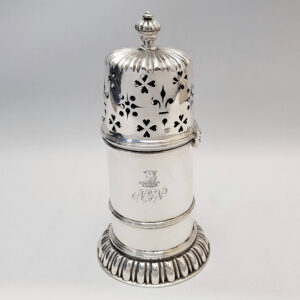
1686
Clemont Stoner
10425 James II Antique Silver Caster
It’s rare to find such an early example of this large size and weight. The late 17th century silver muffineer is in the traditional lighthouse design and has a bayonet fitting, typical of these very early casters. The base is plain styled with a broad gadroon band, the top is simply pierced, the holes are quite large as crushed loaf sugar was still in use at this early date. Hand engraved to the front is an armorial crest with initials below. Weight 381g, 12.2 troy oz. Height 20cm, 8ins. Diameter 9.6cm, 3.75ins. London 1686. Maker Clemont Stoner. Sterling silver.
-

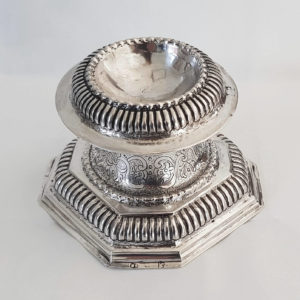
Circa 1698
9935 17th Century Silver Capstan Trencher Salt
Sold
A rare antique Dutch silver salt cellar, late 17th century, of square base form with canted corners. The waisted stem is beautifully engraved and chased with scroll and scalework detail, with the engraved date ‘1698’ above and initials ‘I T’. The base and circular bowl have the embossed fluting typical of the circa 1700 period. Weight 111 grams,3.5 troy ounces. Height 6.3cm. Width of base 9cm. Probably Dutch. Makers mark “HS”. Circa 1698.
-

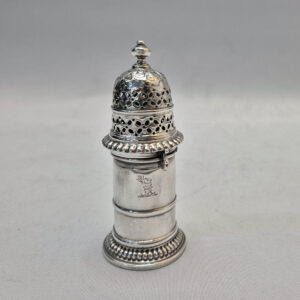
Circa 1707
John Fawdery I
10430 Queen Anne Antique Silver Caster
A charming little antique silver spice caster of lighthouse form from the early 1700’s period with gadroon borders and bayonet fitting. Dinky small size. Hand engraved to the front is a bird crest over a coronet. Weight 67g, 2.1 troy oz. Height 9.5cm, 3.7ins. London circa 1705. Maker probably John Fawdery I. Britannia standard silver 95.8% purity.
-

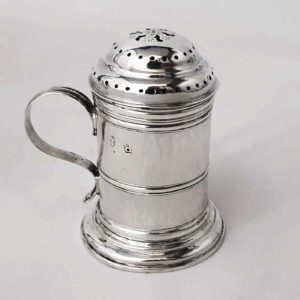
1717
Samuel Hitchcock
9902 George I Silver Kitchen Pepper
An early antique silver kitchen pepper with simple plain styling, having a ring handle, pull off lid and centre horizontal band. Weight 61 grams, 1.9 troy ounces. Height 8cm. Diameter of base 5.5cm. London 1717. Maker Samuel Hitchcock. Britannia standard silver.
-

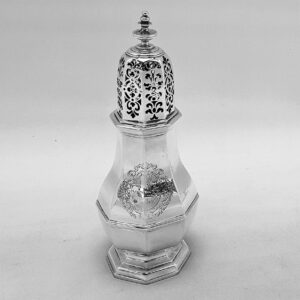
1718
John Fawdery I
10345 George I Antique Silver Caster
An antique silver sugar caster (muffineer) from the early 1700 period in the desirable octagonal shape. The pull off top has panels of pierced decoration. Hand engraved to the front is a decorative cartouche containing a family armorial. Weight 361 grams, 11.6 troy oz. Height 21 cm. London 1718. Maker John Fawdery I. Britannia standard silver 95.8% purity.
-

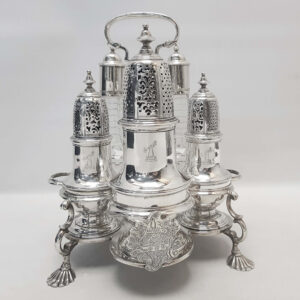
1738
Samuel Wood
10327 George II Silver Warwick Cruet
Sold
A handsome antique silver cruet set with a matching set of 3 silver casters and 2 silver and faceted crystal oil and vinegar bottles. The cinquefoil frame has 4 shell feet and a shaped decorative cartouche to the front with a hand engraved armorial. Each caster and bottle bears the same matching crest. Total weight of silver 1288 grams, 41.4 troy ounces. Caster height 17.75cm and 14cm. Bottle height 17cm. London 1738. Maker Samuel Wood, known for his silver casters.
-

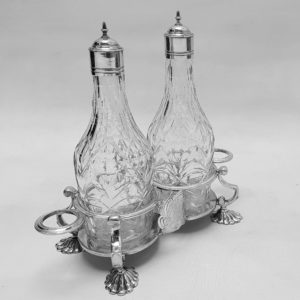
Circa 1750
10274 George II Antique Silver Oil and Vinegar Set
A good quality Irish antique silver condiment set with broad shell feet and a carrying handle. Very heavy weight and thick gauge silver. The silver frame has a handsome wheatsheaf and shell design cartouche containing an unusual hand engraved armorial of “dancing pigs below 2 axes”, possibly for one of the Irish Mac Sweeney lines The cut crystal bottles are very beautiful and have detachable silver tops which fit onto the side rings when the bottles are in use. Weight of stand and silver tops 477 grams, 15.3 troy oz. Total height 19.7cm. Stand width 21cm. Bottle height 17.3cm. Dublin circa 1750. Sterling silver. 18th century.
-

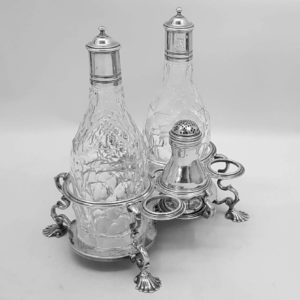
1751
Elizabeth Godfrey
9913 George II Silver Cruet Set
A rare early English silver cruet with two bottles for oil and vinegar and a small silver castor or pepperette. Excellent weight and large size. The heavy cut crystal bottles have multi-faceted cut decoration, typical of the period. The silver frame has an acanthus scroll carrying handle and side supports for the bottle tops and pepperette. The top of the frame has a hand engraved armorial which matches those on the bottle tops. Total weight of silver 955 grams, 30.7 troy ounces. Height 23.5cm (overall), 20.7cm (bottle), 9.5cm (pepper). Base measures 19.3 x 16.3cm. London 1751. Maker Elizabeth Godfrey, a highly respected Huguenot lady silversmith.
-

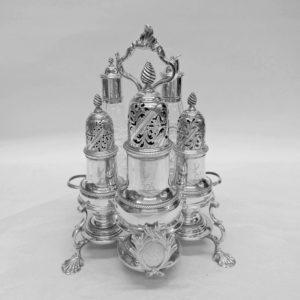
1761 - 1764
John Delmester
10390 George III Antique Silver Warwick Cruet
A handsome antique silver cruet set with a matching set of 3 silver casters and 2 silver topped and faceted crystal oil and vinegar bottles. The cinquefoil frame has 4 shell feet and a shaped decorative cartouche containing a hand engraved armorial. An unusual feature is that one small caster has been fitted with a plain inner sleeve; this is known as a “blind caster” which is the earliest form of mustard pot. Total weight of silver 1498 grams, 48.1 troy ounces. Caster height 19.5 and 16 cm, bottle height 18.3 cm, each with a matching hand engraved crest. Casters London 1764, frame London 1761. Maker John Delmester.
-

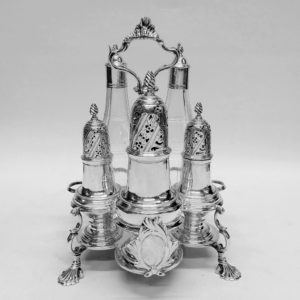
1762
John Delmester
9155 George III Antique Silver Warwick Cruet
Sold
A handsome antique sterling silver cruet set with a matching set of 3 silver casters and 2 silver topped and faceted crystal oil and vinegar bottles. The cinquefoil frame has 4 shell feet and a shaped decorative cartouche containing a hand engraved armorial. Total weight of silver 1214 grams, 39 troy ounces. Caster height 17 and 13.5 cms, bottle height 19 cms, each with a matching hand engraved crest. Casters and frame London 1762. Maker John Delmester.
-

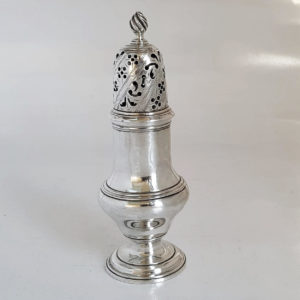
1766
Richard Palmer
8293 George III Silver Caster
A plain style antique silver castor with pierced top and spiral finial. Solid chunky weight and feels good in the hand. The top is fitted with an inner lining to reduce the size of the holes making the caster more suitable for modern day (finer ground) condiments. Weight 177 grams, 5.6 troy ounces. Height 14.8 cms. London 1766. Maker Richard Palmer. Sterling silver.
-

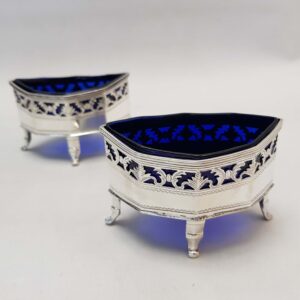
1792 - 1798
Naphtali Hart & Duncan Urquhart
10286 Pair of George III Silver Salts
Sold
An elegant pair of silver salt cellars of oval form on simple scroll feet. The panelled sides have pierced decoration and bright cut engraving. Original Bristol blue glass liners with star cut bases. Total weight of silver 110 grams, 3.5 troy ounces. Height 6cm. Top measures 9×5.7cm. London 1792/8. Maker Duncan Urquhart & Napthali Hart. Sterling silver. 18th century.
-

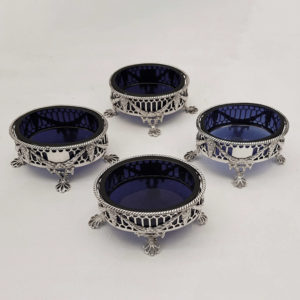
1793
Edward Lowe
9976 George III Antique Silver Salts
Sold
An elegant set of 4 of antique sterling silver salt cellars of oval form with pretty pierced decoration with swags. Blue glass liners. Lovely classical style with rope borders and standing on pierced shaped feet. Weight of silver 218 grams, 7 troy ounces. Height 5cm. Top measures 8.3 x 6.1cm. London 1793. Maker Edward Lowe.
-

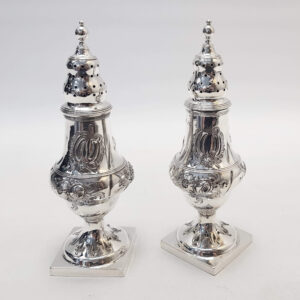
1802
John Moore
10288 George III Silver Pepper Shakers
A decorative pair of antique silver peppers of tall baluster form with pierced detachable tops. Excellent weight. To the front is a flower and scroll cartouche and the body is embossed with pretty flower heads and foliate scrolls. The condiments are mounted asymmetrically on square bases. Weight (pair) 216 grams, 6.9 troy ounces. Height 16.9cm. Base 5x5cm. London 1802. Maker John Moore. Sterling silver. 19th century.
-

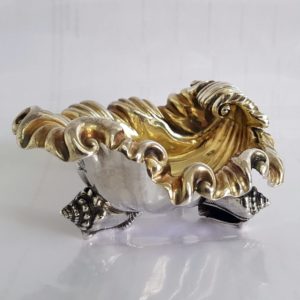
1830
Paul Storr
10226 Pair of Antique Silver Salts
Sold
A pair of superb quality silver salt cellars by the world famous English silversmith Paul Storr. Excellent quality and good gauge silver as you’d expect from this sought after maker. Each rococo sea shell is supported on three conch shell feet and has the original bright gilt interior. Hand engraved to the front is a crest of a hand clutching a dagger. Total weight 255 grams, 8.1 troy ounces. Height 5cm. Top measures 10x9cm. London 1830. Maker Paul Storr. Sterling silver.
-

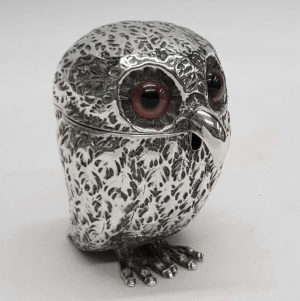
1848
Charles‚ Thomas and George Fox
9413 Antique Silver Owl Mustard Pot
A fine and rare antique sterling silver novelty mustard pot in the form of an owl. With realistically chased plumage, a hinged cover and red glass button eyes. Fitted with a blue glass liner. Weight 184 grams, 5.9 troy ounces. Height 9.5 cms. Diameter 6.3 cms. London 1848. Maker Charles Thomas & George Fox.
-

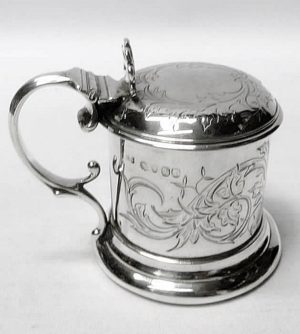
1849
Benjamin Smith
7613 Antique Silver Mustard Pot
Sold
An excellent sterling silver mustard pot of circular form with a hinged lid by the highly regarded Benjamin Smith. The body and lid with a pretty hand engraved decoration with flowers and scrolls, the front with a crest of a stag encircled by a snake. Original blue glass liner. Weight 153 grams, 4.9 troy ounces. Height 8.5cm. Diameter of base 7.5cm. London 1849. Maker Benjamin Smith.
-

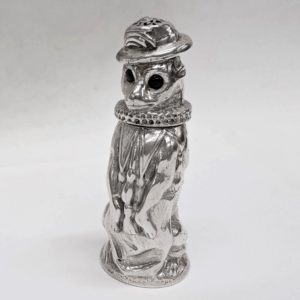
1869
Charles Stuart Harris
9353 Victorian Silver Dog Pepper
Sold
A charming novelty sterling silver pepperette in the form of Punch and Judy’s dog “Toby”. Wearing his distinctive trademark bowler hat and the ruffle collar with tassles. Detachable head and glass eyes. Underneath there is a Victorian lozenge registration mark. Total weight 58 grams, just under 2 troy ounces. Height 10 cm. London 1869. Maker Charles Stuart Harris.
-

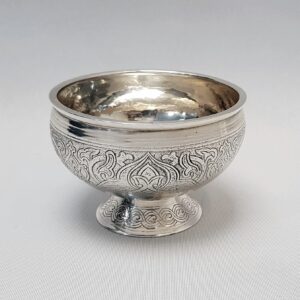
Circa 1870 - 1880
Pavel Sazikov
10413 Russian Antique Silver Salt
An interesting example of Russian Imperial silver made by the master silversmiths of Pavel Sasikov in St Petersburg. Fashioned from heavy gauge silver, the salt cellar is hand engraved with a distinctive design of Eastern motifs on a matted background. Excellent quality and feels good in the hand. Weight 95g, 3 troy oz. Height 5.1cm. Diameter 7.5cm. Made in St Petersburg, Russia. Circa 1870-1880. Silver grade 84 zolotniks.
-

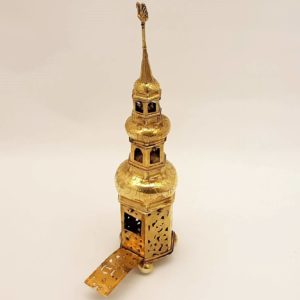
Circa 1890
9629 Antique German Silver Spice Tower
Sold
Of Jewish interest. A large continental silver spice box in the form of a medieval tower with a turret surmounted by a cockerel. All over gilded. The top 2 sections, each containing a bell, sit above the spice box which has pierced and engraved decoration. The box has a drop-down door with scroll catch. Weight 286 grams, 9.1 troy ounces. Height 32 cm. Continental silver marks. Possibly Hanau, Germany. Circa 1890.
-

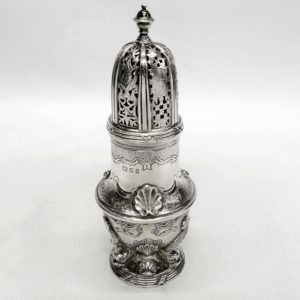
1926
Crichton Brothers
9218 Antique Silver Castor
A fine quality sterling silver sugar castor in the George II Huguenot style. Cast silver. The chased detail is superb. The pierced pull off top is engraved with face masks and baskets of flowers. The body has dolphin supports, ribbon and reed borders, and shell motifs. Weight 410 grams, 13.1 troy ounces. Height 18 cms. London 1926. Maker Crichton Brothers who specialised in fine quality copies of early English silver.
Recently Viewed Products
-

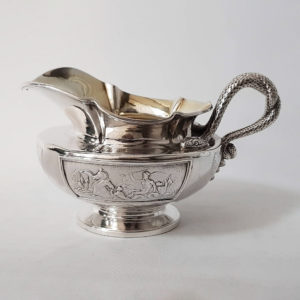
1834
William Barber
9978 Antique Silver Jug
A magnificent antique sterling silver cream jug with a bright gilt interior; the handle formed as two intertwined serpents. To the front and back there are classical scenes of the god Neptune with sea horses and mermen. Weight 355 grams, 11.4 troy ounces. Height 9.5cm (to top of handle). Width 11.5cm. Spread 15.8cm. London 1834. Maker William Barber. Sterling silver.
-

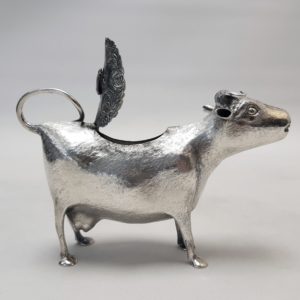
1767
John Schuppe
10245 George III Silver Cow Creamer
Sold
An antique silver cream jug in the form of a model cow. The cavity below the lid is filled with cream which is poured out through the cow’s mouth using the curled tail as a handle. Simple figuring and naive expressive face. The body is all over chased with a charmingly realistic hairy finish. Weight 143 grams, 4.5 troy ounces. Spread 14.7cm. Height 9.2cm (top of horns). London 1767. Maker John Schuppe. Sterling silver. 18th century.
-

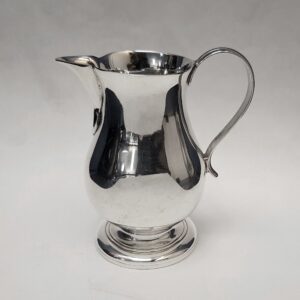
1734
Richard Gurney And Thomas Cooke
10341 George II Antique Silver Jug
A pretty little silver sparrow beak jug with a compact body and spreading foot. Good plain style. Good patina. Weight 58 grams, under 2 troy oz. Height 7.7cm. Spread 6.8cm across the top. London 1734. Maker Thomas Cooke & Richard Gurney. Sterling silver.
-

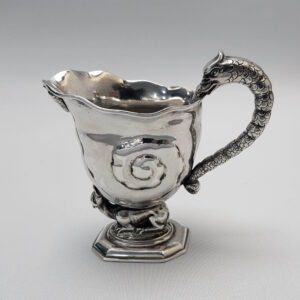
Circa 1720
David Willaume
10362 George II Antique Silver Jug
Sold
An interesting little antique silver cream jug formed of an auricular shell with a ribbed serpent scroll handle and raised on a dragon support. Exquisite workmanship and very heavy gauge silver. Faint traces of original gilding. Contains 75ml. Weight 252g, 8.1 troy oz. Height 10.4cm (top of handle)/9cm (lip). Spread 10.8cm. Foot 5.3 x 4.1cm. Unmarked silver. Probably David Willaume. Circa 1720.